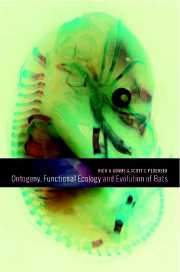Book contents
- Frontmatter
- Contents
- List of contributors
- 1 Integrating ontogeny into ecological and evolutionary investigations
- 2 Bat phylogeny: an evolutionary context for comparative studies
- 3 Early embryology, fetal membranes, and placentation
- 4 Brain ontogeny and ecomorphology in bats
- 5 Evolutionary plasticity and ontogeny of the bat cochlea
- 6 Skull growth and the acoustical axis of the head in bats
- 7 Ontogeny of the chiropteran basicranium, with reference to the Indian false vampire bat, Megaderma lyra
- 8 A theoretical consideration of dental morphology, ontogeny, and evolution in bats
- 9 Wing ontogeny, shifting niche dimensions, and adaptive landscapes
- 10 Ontogeny and evolution of the hindlimb and calcar: assessing phylogenetic trends
- 11 A comparative perspective on the ontogeny of flight muscles in bats
- 12 The ontogeny of behavior in bats: a functional perspective
- Index
2 - Bat phylogeny: an evolutionary context for comparative studies
Published online by Cambridge University Press: 17 August 2009
- Frontmatter
- Contents
- List of contributors
- 1 Integrating ontogeny into ecological and evolutionary investigations
- 2 Bat phylogeny: an evolutionary context for comparative studies
- 3 Early embryology, fetal membranes, and placentation
- 4 Brain ontogeny and ecomorphology in bats
- 5 Evolutionary plasticity and ontogeny of the bat cochlea
- 6 Skull growth and the acoustical axis of the head in bats
- 7 Ontogeny of the chiropteran basicranium, with reference to the Indian false vampire bat, Megaderma lyra
- 8 A theoretical consideration of dental morphology, ontogeny, and evolution in bats
- 9 Wing ontogeny, shifting niche dimensions, and adaptive landscapes
- 10 Ontogeny and evolution of the hindlimb and calcar: assessing phylogenetic trends
- 11 A comparative perspective on the ontogeny of flight muscles in bats
- 12 The ontogeny of behavior in bats: a functional perspective
- Index
Summary
INTRODUCTION
Evolution is one of the unifying theories of modern biology. The fact that organisms (including bats) can and have evolved requires us to consider the historical origins of traits when seeking to understand the similarities and differences among taxa. Evolution may act upon any aspect of organisms, including their biochemistry, ontogeny, morphology, ecology, and behavior. Understanding modern patterns of diversity clearly requires an evolutionary perspective.
One of the principal methods available for addressing evolutionary questions is phylogenetic analysis. As generally understood, phylogenetic analysis comprises the gathering and analysis of data to generate and test hypotheses of phylogenetic relationships, usually (but not necessarily) using cladistic methods. A second step, which may be pursued regardless of the source of phylogenetic trees, consists of mapping taxon characteristics onto trees to investigate patterns of evolution of these features. Traits that can be considered in phylogenetic analyses range from DNA sequences and morphological features to behavioral characteristics; the data employed usually reflect both the nature of the questions being asked and the interests and expertise of the researcher.
Phylogenetic studies of bats are being published at an ever-increasing rate, and well-supported phylogenies for many groups are now available. These hypotheses of evolutionary relationships offer unprecedented opportunities for reconstructing historical patterns of change in different bat lineages. In keeping with the nature of this volume, the goals of this chapter are to 1) discuss briefly the types of data now being used to build bat phylogenies and the methods used to evaluate levels of perceived support for alternative phylogenetic hypotheses, 2) summarize the present state of understanding of bat relationships at several taxonomic levels, and 3) provide examples of how bat phylogenies can be used to provide evolutionary interpretations of morphological, ecological, and behavioral traits.
- Type
- Chapter
- Information
- Ontogeny, Functional Ecology, and Evolution of Bats , pp. 9 - 58Publisher: Cambridge University PressPrint publication year: 2000
- 12
- Cited by



